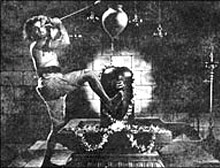 Mohan Bhavanami, the Chief Producer of the Film Division of the Government of India, made the first Kannada silent film, Mricchakatika, in 1929. In 1932 came two talkies, Bhaktha Dhruva and Sati Sulochana. At first the theatre provided the inspiration and artistic resources for the filmmakers, but cinema evolved somewhat sporadically until the 1950s. There were several reasons for this: the absence of sponsorship, lack of adequate technical facilities and the contentment of the audiences with seeing Hindi, Tamil and Telugu films. However, by the 1960s, the State Government decided to introduce subsidies for film production and to recognize good filmmaking by instituting an award system.
Mohan Bhavanami, the Chief Producer of the Film Division of the Government of India, made the first Kannada silent film, Mricchakatika, in 1929. In 1932 came two talkies, Bhaktha Dhruva and Sati Sulochana. At first the theatre provided the inspiration and artistic resources for the filmmakers, but cinema evolved somewhat sporadically until the 1950s. There were several reasons for this: the absence of sponsorship, lack of adequate technical facilities and the contentment of the audiences with seeing Hindi, Tamil and Telugu films. However, by the 1960s, the State Government decided to introduce subsidies for film production and to recognize good filmmaking by instituting an award system.The Navya literary tradition of the Kannada languagehad a tremendous influence on cinema - opposition to Brahmanical control and rituals was the major aspect of this movement. It originated with Gopalakrishna Adiga's volumes of poetry - Nadedu Banda Dari (1952) and Bhumigita (1959) and acknowledged its debt to Kafka, Freud, Camus and Sartre. By placing the protagonist within the existing culture and mass impact, Navya distanced itself from romanticism of any kind. Ananthamurthy's stories represent the pinnacle of this tradition. The three films directly associated with it are Samskara (1970), Pallavi (1976), and Ghattashraddha (1977). Director duo Girish Kasaravelli and G. V. Iyer Kasaravalli have always made films that have been concerned with the stifling Brahminical orthodoxy that cloaks itself in 'puritanical ritual' and explores this theme in Ghattashraddha. Iyer's Adi Shankaracharya (1983), which won him the Golden Lotus, was the first feature film to be made in Sanskrit and is a tribute to the eighth century sage Shankara who, expounded the Advaita (non dualist) philosophy.
In the year 1934, Bhakta Dhruva was directed by P.Y. Altekar, the film starred Master Muthu, T. Dwarkanath, H.S. Krishnamurthy Iyengar and G. Ganesh. In honour of A.V. Varadachar - of Ratnavali Theatre Company - the film had his grandson in the title role and other company artistes as well. The story is from the Puranas - of Dhruva who ultimately becomes a star in the skies. This was the first Kannada film but was released after Sati Sulochana. Sati Sulochana was directed by Y.V. Rao, the film starred R. Nagendra Rao, M.V. Subbaiah Naidu, Lakshmibai, and Y.V. Rao. The defeat of Ravana by Lord Rama, and the killing of Inderjit (Ravana's son) is viewed through the eyes of Sulochana, Inderjit's wife.The war scenes were filmed with 2 cameras!
In 1936 came Samsara Nauka, directed by H. L. Simha, the film starred B.R. Panthulu, M.V. Rajamma, Dikki Madhava Rao, S.K. Padmadevi, and M.S. Madhava Rao. The hero marries against his grandfather's wishes and is cast out. His troubles do not end here - he finds no favour with his in-laws, loses his job, and finds himself accused of murdering the bride his grandfather had chosen for him. The film was adapted from a play by the Chadrakala Natak Mandali, and remained true to the original reformist ideal.

Bedara Kannappa was directed by H.I.N. Simha, the film starred Rajkumar, G.V. Iyer, Pandharibai, and Narasimhraju. Based on folklore, the film is about a god and goddess exiled to Earth. They are reincarnated as the children of hunters, and the god-human has to endure a host of tribulations.This was the first film of Kannada superstar Rajkumar. The theme itself is originally of the ragales (couplets) of the thirteenth century poet-saint Harihara.
In 1954 C.V. Raju, directed by, the film Natashekhara which starred Kalyana Kumar, Sandhya, Vidya, and H.R. Sastry - A story about a young man running away from home to be a film star. This was the debut film of Kalyana Kumar who, too, had run from home with stars in his eyes. - A very successful film. In 1968 came Hannele Chiguridaga directed by M.R. Vittal, the film starred R. Nagendra Rao, Raj Kumar, Kalpana, Arun Kumar, and B.V. Radha. The social issues of widow remarriage and a suitable bride were tackled but the film was careful to not weaken patriarchal authority. The patriarch as played by R. Nagendra Rao remains a memorable character and is widely regarded as among the actor's best performances.
Gejje Pooje came in the year 1970 directed by S.R. Puttana Kanagal, the film starred Kalpana, Gangadhar, Leelavathi, Arathi, and Pandharibai. A woman brought up by a brothel owner leaves for another city to protect her daughter. The past catches up when the mother's former paramour reappears - the daughter's engagement is called off, compelling a return to the mother's past profession. The director made a strong statement about the tragic turn a woman's life often takes. The camerawork differed for the depiction of the two worlds - the shallow respectability of the middle-classes and the exploitative spirit of brothels. In the same year came Samskara: directed by Pattabhi Rama Reddy, the film starred Girish Karnad, Snehlata Reddy, P. Lankesh, B.R. Jayaram, Dasharathi Dixit, and Laxmi Krishnamurthy. A renegade Brahmin, his low-caste mistress - and the other Brahmins who refuse to cremate him. His mistress appeals to a scholar who is initially at a loss for the solution. After a sexual encounter with her, he is forced into introspection. A talk with an ordinary villager helps him realize the unifying reality of all beings and his affinity with the dead man: he performs the last rites. Ananthamurthy's story formed the basis for Girish Karnad's screenplay of the triumph of humanitarian values over dogmatism.
For more visit the link below: